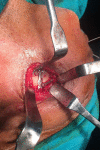Comparison of two L shaped Plate on Plate Versus Single Conventional L Miniplate in Fixation of Subcondylar Mandibular Fractures
- PMID: 31371888
- PMCID: PMC6639440
- DOI: 10.1007/s12663-018-1154-8
Comparison of two L shaped Plate on Plate Versus Single Conventional L Miniplate in Fixation of Subcondylar Mandibular Fractures
Abstract
Aim: To compare and evaluate treatment outcome and postoperative complications in subcondylar fractures of mandible-single L shape plate versus two L shape plate-using plate on plate technique.
Materials and methods: The clinical trial had a total of ten patients (ten unilateral subcondylar fracture sites), which were divided randomly into two groups of five each. Group I patients underwent open reduction and internal fixation with single L shaped miniplate and Group II ORIF was done with two L shaped miniplates by plate on plate technique.
Results: Both the groups showed comparable results in terms of postoperative complications. Few cases in Group I presented with minor occlusal discrepancy which was easily corrected with transitional inter-maxillary fixation(IMF) for 1 week, and none of the Group II cases required postoperative IMF, but stability in Group II was better than Group I.
Conclusion: The results of this trial suggested that the treatment of mandibular condylar fractures with 2 (2-D) plates placed one over the other is better suited than conventionally practiced single-plate fixation. Increased 3-dimensional stability, low morbidity and infection rates are the advantages offered by 2-plate technique of ours.
Keywords: 3D plates; Miniplates; Plate on plate; Subcondylar fracture.
Conflict of interest statement
Conflict of interestAuthors have no conflict of interest.
Figures










Similar articles
-
Two miniplates versus 3-dimensional plate in the management of mandibular subcondylar fractures: a retrospective analysis.Oral Maxillofac Surg. 2021 Dec;25(4):457-461. doi: 10.1007/s10006-021-00938-y. Epub 2021 Jan 11. Oral Maxillofac Surg. 2021. PMID: 33432472
-
Which fixation methods are better between three-dimensional anatomical plate and two miniplates for the mandibular subcondylar fracture open treatment?J Craniomaxillofac Surg. 2019 May;47(5):771-777. doi: 10.1016/j.jcms.2019.01.033. Epub 2019 Feb 1. J Craniomaxillofac Surg. 2019. PMID: 30770259
-
Fixation of subcondylar fractures of the mandible: a randomized clinical trial comparing one trapezoidal plate with two miniplates.Int J Oral Maxillofac Surg. 2021 Jun;50(6):756-762. doi: 10.1016/j.ijom.2020.10.009. Epub 2020 Dec 4. Int J Oral Maxillofac Surg. 2021. PMID: 33280989 Clinical Trial.
-
Locking Plate System Versus Standard Plate Fixation in the Management of Mandibular Fractures: Meta-Analysis of Randomized Controlled Trials.J Craniofac Surg. 2017 Sep;28(6):1456-1461. doi: 10.1097/SCS.0000000000003857. J Craniofac Surg. 2017. PMID: 28708651
-
A meta-analysis comparing the 2.0-mm locking plate system with the 2.0-mm nonlocking plate system in treatment of mandible fractures.J Craniofac Surg. 2014 Nov;25(6):2094-7. doi: 10.1097/SCS.0000000000001018. J Craniofac Surg. 2014. PMID: 25304139 Review.
Cited by
-
The Use of 3D Titanium Miniplates in Surgical Treatment of Patients with Condylar Fractures.J Clin Med. 2020 Sep 10;9(9):2923. doi: 10.3390/jcm9092923. J Clin Med. 2020. PMID: 32927799 Free PMC article.
-
Open surgical approach to fractures of the mandibular condyle: surgical technique and associated complications.Turk J Med Sci. 2024 May 22;54(5):1082-1091. doi: 10.55730/1300-0144.5887. eCollection 2024. Turk J Med Sci. 2024. PMID: 39473755 Free PMC article.
References
LinkOut - more resources
Full Text Sources
